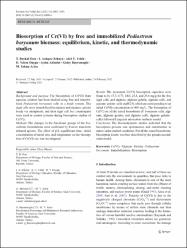Biosorption of Cr(VI) by free and immobilized Pediastrum boryanum biomass: equilibrium, kinetic, and thermodynamic studies

Göster/
Erişim
info:eu-repo/semantics/closedAccessTarih
2012Yazar
Ozer, T. BaykalErkaya, I. Acikgoz
Udoh, Abel U.
Duygu, D. Yalcin
Akbulut, Aydin
Bayramoglu, Gulay
Arica, M. Yakup
Üst veri
Tüm öğe kaydını gösterÖzet
The biosorption of Cr(VI) from aqueous solution has been studied using free and immobilized Pediastrum boryanum cells in a batch system. The algal cells were immobilized in alginate and alginate-gelatin beads via entrapment, and their algal cell free counterparts were used as control systems during biosorption studies of Cr(VI). The changes in the functional groups of the biosorbents formulations were confirmed by Fourier transform infrared spectra. The effect of pH, equilibrium time, initial concentration of metal ions, and temperature on the biosorption of Cr(VI) ion was investigated. The maximum Cr(VI) biosorption capacities were found to be 17.3, 6.73, 14.0, 23.8, and 29.6 mg/g for the free algal cells, and alginate, alginate-gelatin, alginate-cells, and alginate-gelatin-cells at pH 2.0, which are corresponding to an initial Cr(VI) concentration of 400 mg/L. The biosorption of Cr(VI) on all the tested biosorbents (P. boryanum cells, alginate, alginate-gelatin, and alginate-cells, alginate-gelatin-cells) followed Langmuir adsorption isotherm model. The thermodynamic studies indicated that the biosorption process was spontaneous and endothermic in nature under studied conditions. For all the tested biosorbents, biosorption kinetic was best described by the pseudo-second-order model.
Kaynak
ENVIRONMENTAL SCIENCE AND POLLUTION RESEARCHCilt
19Sayı
7Koleksiyonlar
- Scopus İndeksli Yayınlar Koleksiyonu [2667]
- WoS İndeksli Yayınlar Koleksiyonu [3310]
- Yayın Koleksiyonu [173]

















